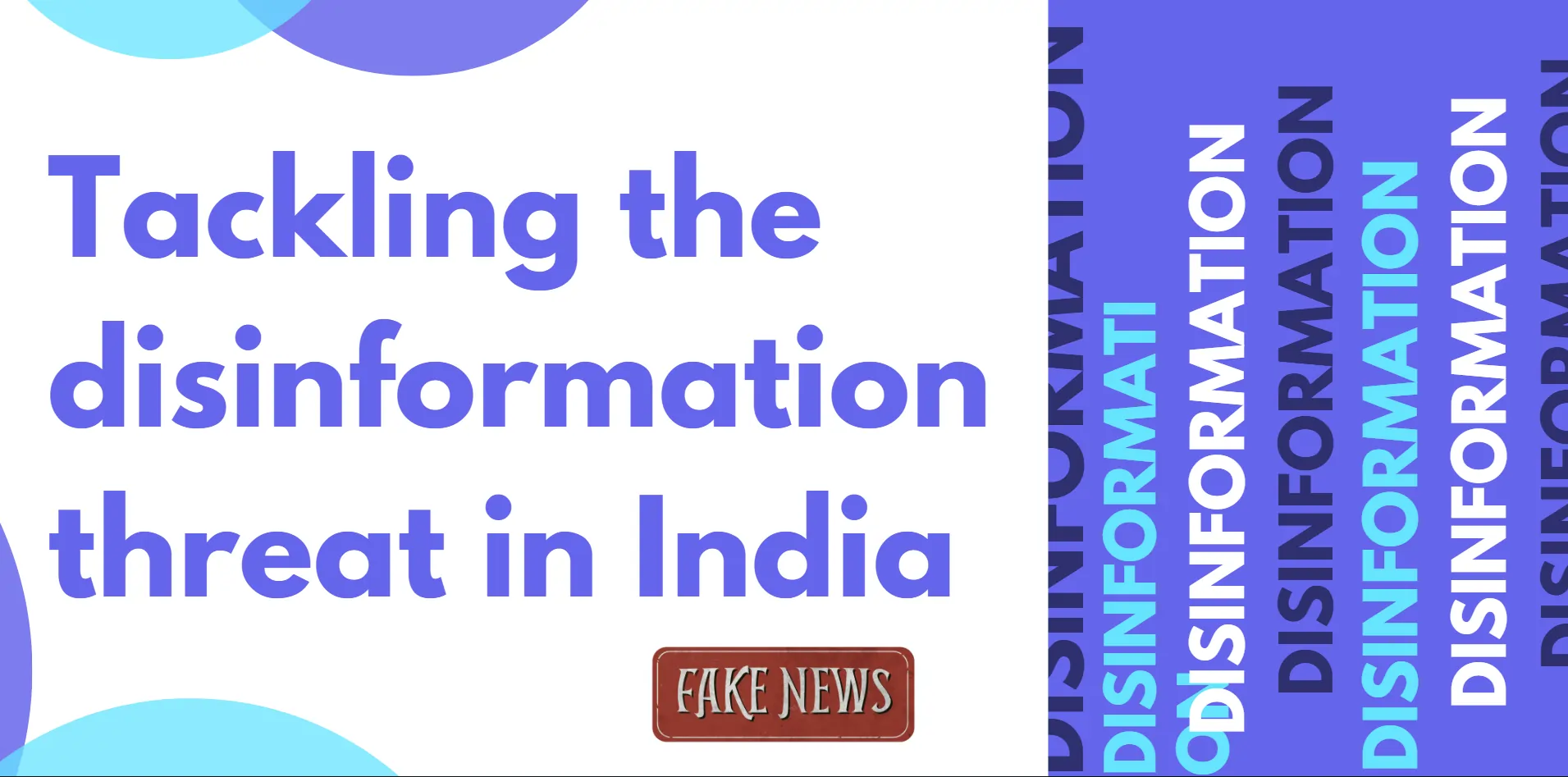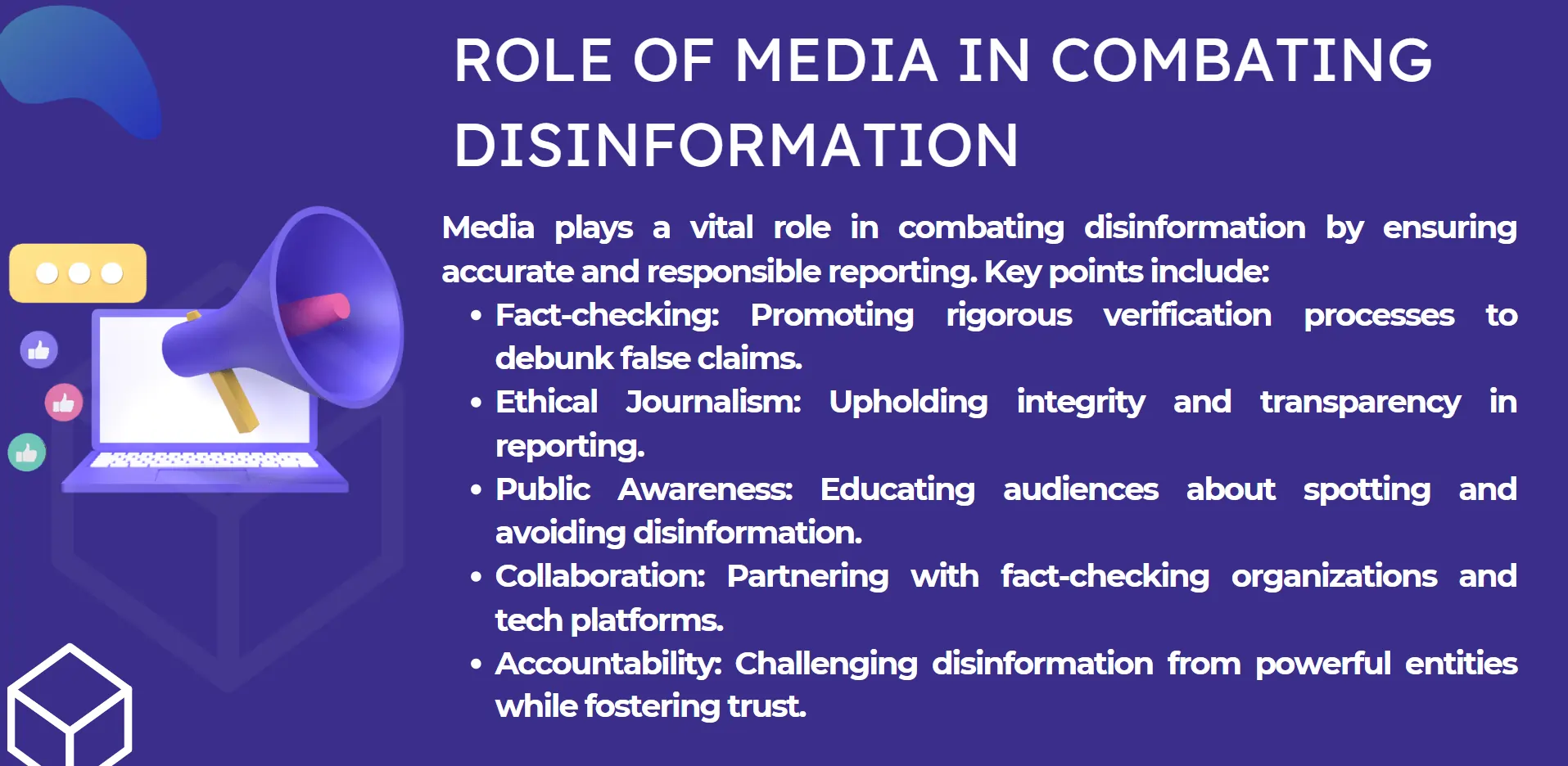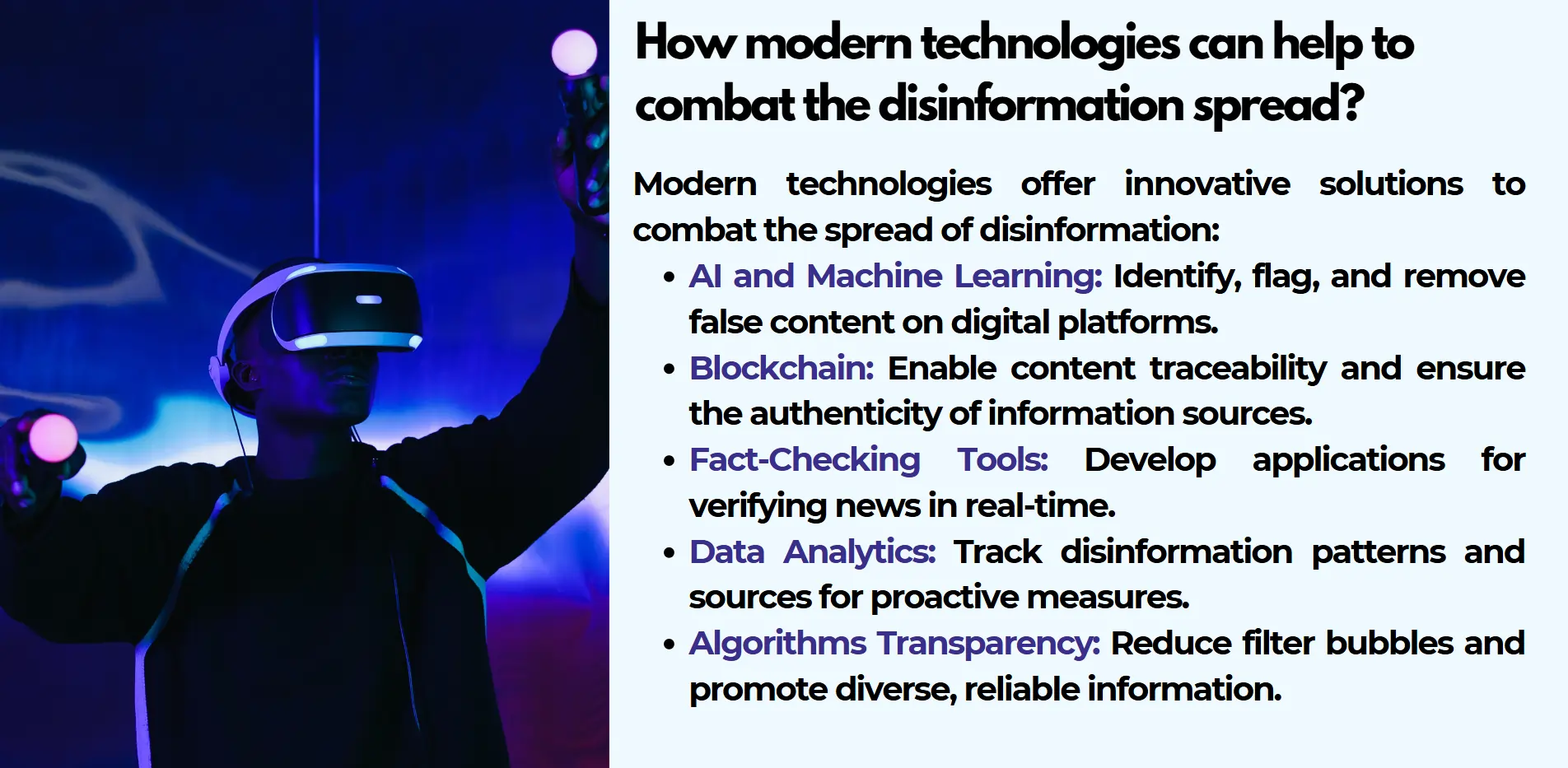The issue defies technological solutions while endangering the shared values of democracy and creating obstacles for group defence of truth, equality and unity across the population.

Societies across the globe face a serious threat because of deliberate misinformation spread which includes India as one of the affected territories. Disinformation poses fundamental threats to India's society and economy; also it destabilizes political systems because of its large population diversity. Digital platforms together with social media's widespread use created a powerful environment which allows anyone to easily manufacture and spread deceptive stories. Disinformation destroys trust through false information that promotes division thus working against democratic principles. This Article investigates the disinformation environment across India by examining its origins and causes together with their resulting effects while suggesting methods to counteract this problem. This initiative seeks to develop a society that understands better and remains strong against misinformation.
The Landscape of Disinformation in India
Disinformation operates across a vast complex field throughout India because the nation possesses broad diversity alongside swift technological progress. More than one billion digital platform users have made India an enthusiastic platform for spreading false content. Through networks ranging from social media to messaging apps including WhatsApp and traditional media outlets false information easily spreads to millions of people within small timeframes.
The forms of disinformation spreading throughout India include partisan political spread as well as false health narratives and financial deceit. The primary purpose of political content exists to control public perception so it affects voting results and damages democratic systems. The pandemic prompted a surge in health-related misguidance regarding vaccines and disease awareness since unreliable information spread widely. Premium financial schemes which appear as investment prospects and work promises predate the innocent and defenceless.
Disinformation in India finds its main distribution through regional languages in order to reach the diverse population of India. National oversight systems are unable to detect regional content because it avoids their jurisdiction making challenges for monitoring and countering these messages. Social tensions alongside violent incidents result from when false narratives target the communal and caste divides that already exist within Indian society.
The contribution of technological elements makes the situation more severe. Hosting algorithms on social platforms produce isolated information bubbles that strengthen prejudice and distribute fabricated news inside confined online groups. Cyberspace protects mischievous actors because they can spread untruthful information without risk of retribution.
Pursuing disinformation solutions in India becomes difficult because of its extensive size and intricate nature. Knowledge of this complex framework serves as the first step to solve the problem. Stakeholders can use pattern analysis and driver assessment to form collaborative strategies that develop media literacy and establish ethical content regulations and enhance monitoring which leads to informed societal harmony.
Impact of Disinformation
Disinformation presents profound effects across society and governance as well as the India’s Bio-economy thus creating an urgent need for solution. Disinformation produces serious and dangerous effects in India due to its broad diversity of cultural backgrounds and linguistic and political differences.
Social collisions happen when disinformation severs trust between communities while it creates social divisions. The technique exploits currently existing cultural split points such as religious beliefs, caste system and geographic affiliations through purposefully distorted information. Such misinformation causes increased social conflict between groups as well as violent behaviour while weakening the unity of communities. The problem of disinformation functions as a major driving force behind hateful verbal attacks that spread extremist doctrines which produce environments filled with fear and hostility.
Disinformation has the most significant political impact when viewed as an issue. News together with propaganda stands as a strong threat to democratic processes because it controls voter opinions. False information spread throughout election campaigns causes citizens to make incorrect choices because it reduces their comprehension of important facts. Disinformation attacks the trust that people have in government institutions combined with democratic institutions and political officials to make the system less stable.
Disinformation creates actual economic expenses which affect businesses and their profitability. Lack of awareness makes people vulnerable to scams and frauds through fake investment schemes or false product advertisements which drain their finances. Businesses face adverse reputational impacts from disinformation attacks that result in reduced consumer trust thus causing harm to their profitability.
The mental stress caused by disinformation campaigns should receive proper evaluation regarding their damaging effects on human well-being. Infinite contact with worrying and deceptive information builds an environment where people experience doubt and face anxiety and disbelief. The inability to distinguish fact from falsity affects decision-making processes together with critical thinking capabilities.
Disinformation evidence demonstrates a broad reach by disrupting all aspects of social cooperation together with political consistency while threatening economic systems. Solving this problem necessitates united action that develops resistance capabilities by teaching the population about false content and establishing strong methods to identify and respond to deceiving information.
Key Drivers behind Disinformation in India
Various technological, socio-political and psychological elements in India together drive disinformation which expands false narratives throughout the entire nation.
Technological Drivers
People can now instantly share false content due to the widespread spread of smartphones and internet access which revolutionized communication methods. Social media together with messaging applications including WhatsApp function as primary channels for allowing disinformation to propagate without any restrictions. Computer programs that focus on user engagement develop self-contained information networks which strengthen biases by showing users solely targeted content that can be easily manipulated. Digital platforms allow criminal elements to spread untrue information because users remain completely unidentified on these systems.
Socio-Political Drivers
The political and social structure of India demonstrates natural conditions for the growth of disinformation. The highly polarized political scene supports propaganda production because political actors intend to harm their enemies and modify what citizens think about public matters. Political organizations along with self-interested groups capitalize on existing social differences including caste system, religious factions and regional loyalties to broadcast selective untrue propaganda leading to tensions rising. The many cultural differences across the country create opportunities for disinformation creators to design propaganda specifically targeted at individual groups leading to greater challenges for detection and elimination.
Psychological Drivers
Human psychological behaviour cantered on confirmation bias provides a major basis for disinformation campaign triumphs. Humans tend to accept and distribute news stories which agree with their personal convictions without checking their truthfulness. False information spreads rapidly because fearful and uncertain situations along with sensationalism tend to drive emotional responses in users who share content impulsively.
Strategies to Combat Disinformation
A fruitful solution to disinformation in India requires teamwork between administrative organizations and technology systems alongside mainstream media and public participation. This emerging threat requires essential involvement from each stakeholder whose role remains vital for its resolution.
Role of the Government
The government must pass and strictly enforce legislation which punishes producers as well as distributors of disinformation. The laws should take steps to penalize the offenders while protecting the freedom of speech. The public benefits from awareness programs teaching people about digital literacy because they learn how to detect and fight false information. Government institutions should work together with technology companies to create streamlined strategies against disinformation.
Media and Technology Companies
Every media organization needs to follow ethical journalism standards while they perform fact-checking to create reliable reports. Collaborating with unaffiliated fact-checking agencies helps organizations build more credible institutions while maintaining accountability standards. Technology companies employ machine learning and artificial intelligence technologies on social media platforms to discover false content which they subsequently delete. These platforms must guarantee clear disclosure about their algorithms to stop false information from replicating repeatedly.

Community and Grassroots Efforts
The development of community resilience depends heavily on local efforts which prove especially vital for areas that lack digital access and for rural communities. Organizations based in communities need to instruct their members about source evaluation methods as well as information verification processes before they share content. The effective reduction of disinformation spreads in India's multicultural environment relies heavily on local-language campaign initiatives.
Individual Responsibility
Every person should protect society from disinformation through the practice of intelligent discrimination with doubting habits. Strong control over information spread happens through basic steps which combine source verification, information verification and inhibit hurried sharing of content.
Case Studies: Successes and Failures
Investigating specific anti-disinformation activities enables researchers to identify effective practices and recognition of weak points for future improvement. The complicated media environment of India creates specific obstacles when it comes to managing false information.
Successes
During the COVID-19 pandemic health-related fake information were successfully controlled. The debunking of false information regarding vaccines and virus treatments and the virus’s nature was achieved through the fact-checking initiatives conducted by Various News with coordination from the Press Information Bureau (PIB). Their immediate responses in regional languages minimized public and factual misinformation spread. Social media platforms launched two initiatives to limit the fast propagation of false content through WhatsApp forwarded labelling and message forwarding limit reductions.
The fight against disinformation has shown success through initiatives originating from communities across the nation. Rural India has experienced success through digital literacy programs which allowed local citizens to detect and challenge fabricated news stories. Non-government organizations have executed workshops which have taught individuals proper information evaluation methods that help decrease the effectiveness of disinformation launched in their communities.
Failures
The fight against disinformation has shown notable failures even after achieving several successes. Social media content containing provocative misinformation spread during the 2020 Delhi riots became a catalyst for violent conflicts. The attempts to stop misinformation proved insufficient along with being untimely because they failed to properly tackle such real-time issues.
Disinformation based especially on political issues continues to persist as a major problem. During election periods false political content remains active due to regulatory enforcement failures while it distorts popular voter perception. Political organizations and media outlets need stronger accountability measures because the current situation demonstrates their failure to act proactively.
The recent progress has addressed disinformation challenges yet various difficulties persist in this domain. This research shows that India needs an integrated method which unites digital solutions with classroom learning and government policies to develop a stronger information-based population.
Recommendations and Future Roadmap
A future-oriented comprehensive plan must become operational to properly handle disinformation threats within India. The proposed set of recommendations along with a strategic roadmap offers systematic solutions for this matter.
Policy Recommendations
The fight against disinformation needs new and stronger policies that implement existing regulations. Federal law should enforce consequences for distributing fake information through determined free speech preservation measures. Public agencies need to work alongside technology platforms for developing standardized content moderation procedures as well as platform algorithm transparency guidelines. A centralized authority should oversee digital content to ensure compliance with disinformation laws which will also improve accountability.
Technological Innovations
The battle against disinformation depends heavily on making use of modern technological tools. Technology tools using artificial intelligence and machine learning enable the detection and marking of false content throughout digital platforms. Users will better determine trustworthy information when metadata verification includes accurate timestamp and source information. The creation and promotion of fact-checking platforms in local languages by apps and software developers work as extensive array of linguistic communities throughout India.

Educational Initiatives
Educating people is a necessary step. Academic establishments should create digital literacy programs to teach their students how to evaluate information critically and how to validate its credibility. People from rural communities can learn through community workshops to identify authentic content by acquiring knowledge and skills through participatory educational programs.
Collaborative Efforts
Disinformation represents a community-wide concern whose resolution necessitates teamwork from everyone. The creation of a trust-infused digital environment demands strategic alliances between public institutions, media outlets, technology providers and civil organizations. The combination of joint promotional programs focused on online media literacy helps create stronger barriers against misleading information.
Conclusion
The spread of disinformation presents an on-going danger to every part of Indian society thus it requires immediate unified action by every sector. Multiple reforms directed at policy, campaigns, educational and technological initiatives must be established to combat false information in India. A society built on well-organized collaboration between public departments and media institutions along with technology firms and population groups will develop information resilience and adaptability. Joint collaboration between stakeholders will create an environment where the truth prevails to prevent disinformation from causing harm to Indian democracy and society.